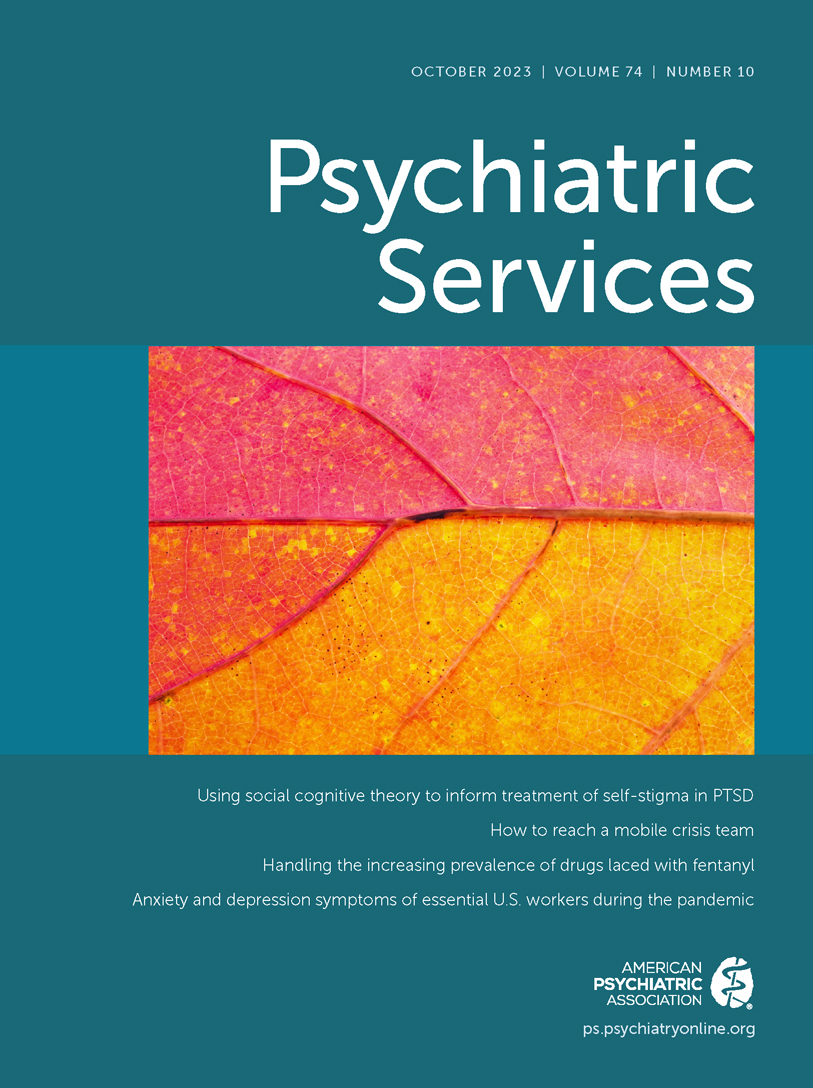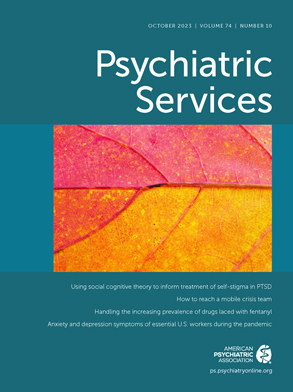Schizophrenia is associated with chronic impairments in social and vocational functioning (
1). Although many features of schizophrenia contribute to the high burden of the illness, treatment-resistant schizophrenia accounts for up to an 11-fold increase in costs relative to treatment-responsive illness (
2). Over 30 years of evidence supports clozapine as a gold standard treatment for treatment-resistant schizophrenia (
3). Evidence from numerous studies indicates that treatment with clozapine is associated with decreased psychiatric hospitalization (
4), greater engagement with outpatient care, and prevention of relapse (
5). More broadly, a twofold decrease in mortality has been estimated for individuals who receive treatment with clozapine, relative to those who do not receive treatment but have refractory symptoms (
6).
However, less is known about clozapine’s impact on community-based care. Entering community-based care is a major goal in the recovery and optimization of longitudinal outcomes of individuals with schizophrenia. Broadly constructed, community integration refers to the extent to which a person lives, participates, and socializes within a community. For individuals with psychiatric disability, including those treated with clozapine, publicly funded residential and social rehabilitative services, in addition to forensic and community-based mental health interventions, are crucial for maintenance of recovery.
We examined clozapine treatment in relation to utilization of services that are critical for community-based care. We focused on data from publicly funded behavioral health and human services in Allegheny County, Pennsylvania, which has over 1.2 million residents across urban, suburban, and rural settings. We examined changes in utilization of behavioral health and human services before and after clozapine treatment among participants adherent to clozapine treatment. Furthermore, given that sociodemographic variables reflecting known disparities in health care access and outcomes may influence the receipt of publicly funded services and the use of clozapine, secondary analyses were stratified by age, race, and gender.
Methods
Database
We used data from the Allegheny County Data Warehouse, which integrates demographic data, administrative health care data (medical and pharmacy), and data related to utilization of community services. The Allegheny County Data Warehouse is an electronic repository of data reflecting utilization of publicly funded human services. It comprises data from more than 20 sources representing program areas, both internal and external to Allegheny County’s Department of Human Services, and encompasses Medicaid- and county-funded behavioral health, housing, forensic, and other public benefit programs. This data set also uniquely captures the use of services, such as mental health and substance use treatment, that are paid for directly by the Department of Human Services or HealthChoices (a Medicaid managed care program). Community-based services included claims for social rehabilitation and community residential services. (Additional details about the service areas included in analyses are provided in Table S1 in the
online supplement to this column.) Each data point represented a service claim. More information on the Data Warehouse is available online (
https://www.alleghenycountyanalytics.us).
Study Population
This project was deemed exempt from human subjects review by the institutional review board of the University of Pittsburgh. We included deidentified data from individuals who had an incident clozapine prescription claim (i.e., no clozapine claims in the year prior) between 2009 and 2016, were between ages 18 and 65, and had a diagnosis of schizophrenia or schizoaffective disorder (ICD-10 F20.x, F25.x) before the index clozapine prescription claim. To identify a clozapine-adherent cohort, we used the proportion-of-days-covered (PDC) method for the 180-day period after clozapine initiation, which is supported by the Centers for Medicare and Medicaid Services. We included individuals who had a PDC ≥80%.
Study Design
To examine changes in utilization before and after clozapine treatment, we used a mirror-image design in which individuals served as their own control, facilitating a within-person comparison. This study design has been used frequently in studies with pre-post designs that compare outcomes before and after an event, which in this study was clozapine-adherent treatment. Among antipsychotic treatments, clozapine is unique in its effectiveness, underutilized status, and federally regulated monitoring system, but the drug requires complex systems of care to support its use (
5). Thus, our mirror-image approach also limited potential confounders associated with matching individuals treated with clozapine to those treated with a comparator drug. We followed STROBE (Strengthening the Reporting of Observational Studies in Epidemiology) criteria for reporting observational findings (
7).
The control (preanalysis) period comprised the 180 days before clozapine initiation (see Figure S1 in the online supplement). The 180 days after clozapine initiation were used to determine treatment adherence (i.e., PDC ≥80%). The subsequent 180 days were used as the analysis period to measure changes in utilization (see Figure S1 in the online supplement).
Statistical Analysis
We used McNemar tests to examine whether the number of individuals who engaged with the service categories of interest differed before and after clozapine treatment. We further stratified our mirror-image analysis by age (≥45 or <45 years), gender (male or female), and race (Black or White). Results were Bonferroni corrected to account for multiple comparisons, with α=0.010 and α=0.003 for our primary and secondary analyses, respectively.
Results
Demographic Characteristics
We identified 163 individuals treated with clozapine who had a PDC of at least 80% (144 days) in the 180-day period after their first clozapine prescription fill. The mean±SD adherence rate in this group was 94%±6%, and mean age was 40.3±12.5 years. Most individuals were men (N=94, 58%); 56% (N=92) were White, and 42% (N=68) were Black.
Mirror-Image Change in Service Utilization
In mirror-image analyses, we observed a significant change in utilization of two service categories, after correction for multiple comparisons (
Table 1). The number of individuals with a psychiatric inpatient stay decreased from 92 to 20 (p<0.001), and the number of individuals receiving community-based services increased from 35 to 79 (p<0.001). Of note, use of forensic services decreased (p=0.04), although statistical significance was not maintained after Bonferroni correction.
Demographic Stratification of Mirror-Image Analyses
We performed further longitudinal analysis across demographic variables (
Table 1). We noted no significant differences between age groups, genders, or races for changes in use of psychiatric inpatient services or in use of community-based services. These results were maintained after stringent Bonferroni correction across demographic strata for both utilization measures. Whereas Black individuals showed no statistically significant difference in use of forensic services before versus after clozapine treatment (p=0.76), White individuals did show such a difference (p=0.02), but this difference became nonsignificant after Bonferroni correction.
Discussion and Conclusions
We used behavioral health and community-based public claims data in Allegheny County, Pennsylvania, to examine service utilization before and after clozapine treatment, with a focus on longitudinal changes. Our study demonstrated that clozapine treatment results in greater service utilization of community-based care and further validated research reporting a decrease in inpatient services with clozapine treatment. To our knowledge, this is the first study to examine the impact of clozapine treatment on community-based services, reflecting integration of local service delivery into treatment, and, more broadly, to examine within-patient changes before and after clozapine treatment in use of county-based public services.
Individuals receiving clozapine often represent a subcohort of individuals with schizophrenia who have chronic and specific community-based needs. Despite evidence of its effectiveness, clozapine is estimated to be underutilized in the United States by a factor of 10 (
8). Although the underutilization of clozapine is caused by many factors, it partially reflects broader challenges of schizophrenia treatment related to the allocation of public resources that support effective recovery (
8). Critically, individuals with treatment-resistant schizophrenia receiving clozapine also require integration of local service delivery in order to maintain recovery.
Our results suggest that clozapine treatment shifts resources from costly inpatient care to services focused on community-based care and long-term recovery, regardless of the patient’s age, gender, or race. These results extend prior effectiveness studies, where individuals receiving clozapine had significantly fewer inpatient admissions and total days hospitalized relative to those receiving nonclozapine second-generation drugs (
4). In addition, our novel findings indicate that clozapine treatment results in higher utilization of publicly funded social rehabilitative and community residential services, enhancing overall community reintegration efforts (
9,
10).
Our analyses also examined forensic data, including mental health justice claims, involuntary commitment petitions, and jail utilization. We noted a trend-level decrease in use of forensic services after clozapine treatment, which may have been driven by race. Future studies with more robust forensic data from public claims data repositories will be helpful to extend our findings.
The strengths of our study included the longitudinal, mirror-image design with a 180-day treatment period and the breadth of community service and health care utilization data that were included. We chose to measure outcomes in the 180 days after a treatment period to minimize confounders related to treatment initiation. Limitations of this study included the observational design and inherent inability to control for factors such as antipsychotic polypharmacy.
Our findings suggest that clozapine treatment is associated with a shift in publicly funded county resources away from inpatient treatment and toward services that reflect community-based care. These results show the downstream effectiveness of clozapine through county-level claims data and highlight services that support the recovery and rehabilitation of individuals with schizophrenia. From the standpoint of high-value care, we believe our findings support the expansion of efforts by Medicaid managed care organizations to promote clozapine utilization for optimal and efficient long-term care. More specifically, our findings support the development of infrastructures that maintain clozapine treatment within community-based services.
Acknowledgments
The authors thank Joan Spinogatti for administrative support and Wilson Mui, M.S., for helpful discussions.

